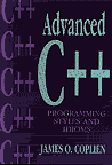|
|
|
<<< Previous speaker
|
next speaker >>>
|
Jim O. Coplien, Creator of C++ idioms, founder of organizational patterns, and leading spokesperson for Agile Architecture

Jim Coplien ("Cope") is the father of Organizational Patterns, is a co-
founder of the Software Pattern discipline, a pioneer in practical
object-oriented design in the early 1990s and is a widely consulted
authority and author in the areas of software design and
organizational improvement. He currently works as Software Architect
and Agile Consultant at Gertrud&Cope in Denmark. He is also a partner
with the Scrum Training Institute, which provides premiere Scrum
training and consulting world-wide. He sits on the editorial board of
the LNCS Pattern Journal, is a Member Emeritus of the Hillside Group,
and is a Certified Scrum Trainer.
Cope does extensive consulting in Europe, North America, and the
Middle East, with a special focus on the Nordic countries. He is a
frequently-sought conference speaker at major European conferences,
and serves as a co-organizer of many patterns conferences. He
regularly gives international seminars on Lean Architecture, Scrum
fine-tuning, patterns, and Agile software development. He has
organized and led outreach programs to make Scrum certification
training available at no cost to students at partner universities
world-wide, as well as to software professionals in emerging
countries. He still writes code for a living once in a while.
He is also a researcher and a past holder of the Vloebergh Endowed
Chair at Vrije Universiteit Brussel. He has past affiliations with
Flinders University in Adelaide and with Manchester University, and is
a past professor at North Central College in the United States. He is
currently doing joint research with Trygve Reenskaug on the DCI
architecture paradigm. He also leads research programs in the theory
of design and organizational patterns. Together with Gertrud Bjørnvig,
he is writing a new book on Lean Architecture and Agile Software
Development, to be published by John Wiley in 2010.
Books
Cope has written or co-authored several books in his career, including the seminal Advanced C++ Programming Styles and Idioms, originally a Jolt Cola productivity winner, and still strong in its sixteenth year.

His most recent book, co-authored with Neil Harrison, is Organizational Patterns of Agile Software Development.

He was one of the first authors to treat the concept of domain-driven design, together with modern programming principles such as object orientation, in his Multi-Paradigm Design for C++:

|
Presentation: "Organizational Patterns and Scrum: Fine-tuning your Agile Implementation"
Time:
Wednesday 11:30 - 12:30
Location:
Rytmisk Sal
Abstract: Scrum is easy to describe but hard to do: you've heard that a million times. And you've read the famous Nokia Test and believe it gives you an easy path to making your Scrum work. However, most Scrum failures are subtle - and after you're dead, you won't even know what got you. Scrum comprises over 50 organizational patterns, each one of which is crucial to a successful software Scrum implementation. Patterns can help you find and fix these problems - come to this hands-on session to learn how.
Prerequisites: Basic knowledge of the Scrum framework
Level: Intermediate
Expectations: What Organizational Patterns are, how to use them to diagnose a Scrum implementation, and how to use them to address subtle problems in Scrum implementations
Workshop: "Scrum tuning using Organizational Patterns"
Time:
Thursday 09:00 - 16:00
Location:
Trifork
Abstract:
This tutorial will teach you how to use organizational patterns to
improve your Scrum implementation. Each organizational patterns is a
small, local approach to strengthening your Scrum Scrum. Patterns
capture solutions to similar problems seen in other organizations, and
because they are incremental and empirical, they can help you with your
Agile process improvement.
The patterns we
present in this class have all been through the extensive reviewing
process of the Pattern Community (PLOP) to ensure that the solutions
are broadly reproducible. Furthermore, each pattern has been
scrutinized by some of the leading Scrum people in the world. Their
conclusions?
We have divided Organizational Patterns into 3 categories:
- One set of Organizational Patterns that map directly to the Scrum
framwork, e.g.: Firewall – Someone has to keep the monkeys off the
developers’ backs. Who would that be in Scrum? Well, the Scrum Master
protects the process and is there by a firewall. Less obvious is that
the Product Owner is also a Firewall, in making sure only one set of
requirements come into a sprint. What about a manager, can a manager be
a Firewall? (also see the pattern Patron Role)
- One set of Organizational Patterns that map directly to a Scrum
software implementation. So even if it is not part of the Scrum
framework, it is still considered good practice, e.g.: Get on with it –
Even if you don’t have a complete, comfortable plan to get started,
take what you know and take it forward to build an initial product.
- One set of Organizational patterns that can inspire thinking and
dialog that amplify Scrum process improvement, e.g.: Face-to-Face
Before Working Remotely that relates the success that comes from having
team members spending some face time at their remote partners’ location
before starting to work across the miles.
At the end of the class you will know how to use patterns to find and improve the weak spots in your Scrum implementation.
Agenda:
Welcome and Introduction
1. Short History of Patterns and Organizational Patterns
2. Scrum in 3 minutes
3. Pattern Overview
4. Organizational patterns in the Scrum context
1. From Scrum to Org Patterns: Looking at Patterns from a Scrum Perspective
2. From Org Patterns to Scrum: Looking at Scrum from a Patterns Perspective
3. Three groups of patterns
5. Solving impediments with patterns
6. Pattern Dependencies
1. Pattern dependencies
2. Pattern sequences
3. Pattern languages
7. Advanced Topics
8. Next steps and homework
All attendees will receive a copy of the book Organizational Patterns of Agile Software Development
Pre-requisite: You should have an understanding of Scrum
|
 |
| |
 Jim Coplien ("Cope") is the father of Organizational Patterns, is a co-
founder of the Software Pattern discipline, a pioneer in practical
object-oriented design in the early 1990s and is a widely consulted
authority and author in the areas of software design and
organizational improvement. He currently works as Software Architect
and Agile Consultant at Gertrud&Cope in Denmark. He is also a partner
with the Scrum Training Institute, which provides premiere Scrum
training and consulting world-wide. He sits on the editorial board of
the LNCS Pattern Journal, is a Member Emeritus of the Hillside Group,
and is a Certified Scrum Trainer.
Jim Coplien ("Cope") is the father of Organizational Patterns, is a co-
founder of the Software Pattern discipline, a pioneer in practical
object-oriented design in the early 1990s and is a widely consulted
authority and author in the areas of software design and
organizational improvement. He currently works as Software Architect
and Agile Consultant at Gertrud&Cope in Denmark. He is also a partner
with the Scrum Training Institute, which provides premiere Scrum
training and consulting world-wide. He sits on the editorial board of
the LNCS Pattern Journal, is a Member Emeritus of the Hillside Group,
and is a Certified Scrum Trainer.





